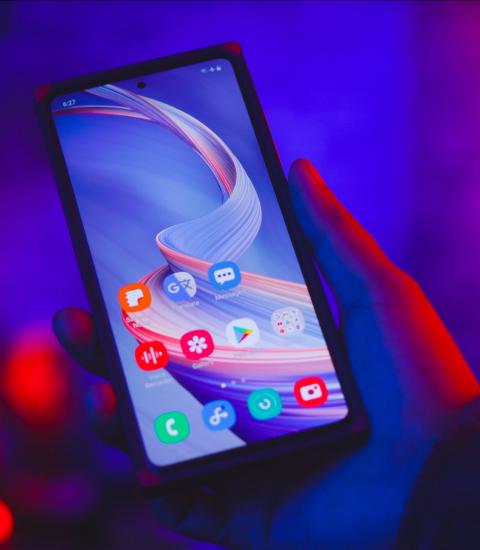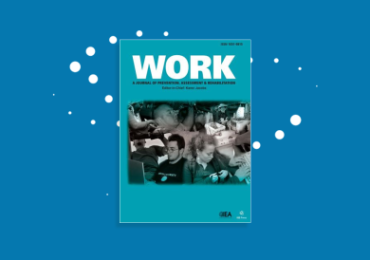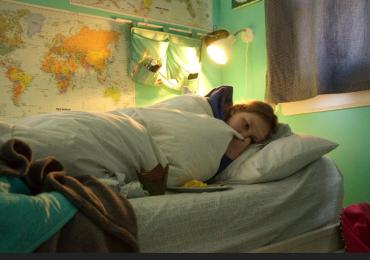
What is digital eyestrain?
Digital eyestrain is the name given to a collection of symptoms that can occur when you use a digital device. It includes headaches, blurred vision, and neck / shoulder pain (2). It is the same concept as “Computer Vision Syndrome” which refers to vision symptoms associated with using a desktop computer. Digital eyestrain is the more modern term, and is used to describe symptoms associated with using any type of digital device.
Why is blue light blamed for digital eyestrain?
Blue light has been in the news for a variety of reasons. There is evidence that exposure to blue light can disrupt our sleep (3). We also know that very high levels can damage the eye’s photoreceptors, for example, staring at a bright light source such as the sun (4).
Many digital devices include LED to illuminate the display, and can include LED components that emit blue light. The amount of blue light emitted from a digital device is very small – it’s less than what you would be exposed to if you stare at the blue sky (5). Subsequently, organisations such as the International Commission on Non-Ionising Radiation Protection (ICNIRP) have stated that blue light from digital devices is unlikely to damage our eyes (6).
Nevertheless, concern about blue light emitted from digital devices has led to proposals that blue light might also cause digital eyestrain – especially if a person’s symptoms only occur after they have been using a digital device.
What is a blue-light filter?
A blue light filter reduces the amount of blue light transmitted to your eyes. This can be achieved in many ways, for example, coatings applied to spectacle lenses, filters that can be fitted to a computer display, and apps that can be used on your digital device (for example, see last month’s blog on blue light and sleep).
There are two categories of filters:
- Blue blocking filters. These have an orange/yellow-coloured tint and reduce blue light transmission to the eye by up to 100%. Blue blocking spectacles are used in environments with high levels of blue light, for example, by nurses working in hospital phototherapy units where babies are treated with blue light for jaundice (7).
- Blue-light filters. These are an almost-transparent coating that is applied to a spectacle lens to reduce blue light transmission to the eye by up to 43% (8). They are sometimes sold with the promise that they will increase your visual comfort when you use a digital device.
Blue light does not cause digital eyestrain
Recently published research shows that blue light does not cause digital eyestrain.
Palavets and Rosenfield (9) asked 23 experimental subjects to read from a tablet device for 30 minutes. In one trial, a blue blocking filter was placed on the display to absorb 99% of blue light emitted from the device – hence almost no blue light from the device reached the subject’s eyes. In a second trial, the subjects read from a tablet device that had a neutral density (grey) filter fitted to the display. This meant that the display had a similar luminance to the blue-blocker condition. The neutral density filter blocked about 50% of blue light reaching the subject’s eyes.
The key findings of this experiment were:
- Higher ratings of eyestrain symptoms after reading from the device for 30 minutes – irrespective of which filter was used. This shows that the reading task itself contributed to eyestrain symptoms.
- No difference in the symptom scores after reading from the device fitted with either filter. This shows that blocking blue light does not affect the symptoms scores.
- No difference in subject’s accommodative (focussing) effort when reading from the device with either filter. Accommodative effort is a common cause of eyestrain, but the results show that it is unaffected by the presence or absence of blue light.
Similar results were reported by Redondo and co-authors with a blue-light filter that was fitted to a computer display and which blocked about 30% of blue light from reaching the eye (10).
Blue light filters do not prevent digital eyestrain symptoms
In a different experiment, Rosenfield and co-authors (11) asked 24 experimental subjects to read from a tablet computer for 20 minutes. Subjects either wore spectacles with a commercially available blue-light filter (filter #1 blocked 98% visible light at 415nm, 41% at 430nm and 11% at 450nm, and filter #2 blocked 57% at 415nm, 15% at 430nm and 10% at 450nm), or a placebo lens that blocked less than 10% of blue light reaching the wearer’s eyes.
The findings were similar to those reported in their previous experiment (see above section):
- Subjects had higher digital eyestrain symptoms after reading from the tablet computer with both types of lenses.
- There was very little difference in symptom scores when wearing either type of spectacle lens.
What should you do if you experience digital eyestrain symptoms?
Digital eyestrain can be caused by a variety of factors. We can’t assume that blue light causes digital eyestrain simply because a device emits blue light and a person experiences symptoms after using the device.
If you experience digital eyestrain symptoms:
- Have your eyes examined. Are your eyes healthy? Do you need to wear spectacles or contact lenses when you use your digital device?
- Wear spectacles or contact lenses with an up-to-date prescription when using your digital device. It’s up to you whether you have a blue-light filter applied to the lenses, but bear in mind there is no evidence that the filter will reduce digital eyestrain.
- Take regular rest breaks from your work.
- Check that your work area and your digital devices are set-up correctly for comfortable vision (12).
References
1. Downie L. Blue-light filtering ophthalmic lenses: to prescribe, or not to prescribe? Ophthalmic and Physiological Optics. 2017;37:640-3.
2. Sheppard A, Wolffsohn J. Digital eye strain: prevalence, measurement and amelioration. BMJ Open Ophthalmology. 2018;3:e000146.
3. Commission Internationale De L'Eclairage. Position statement on non-visual effects of light - Recommending proper light at the proper time (June 28, 2015). Vienna: Commission Internationale De L'Eclairage; 2016.
4. Commission Internationale De L'Eclairage. Position statement on the blue light hazard (April 23, 2019). Vienna: Commission Internationale De L'Eclairage; 2019.
5. O'Hagan J, Khazova M, Price L. Low-energy light bulbs, computers, tablets and the blue light hazard. Eye. 2016;30:230-3.
6. International Commission on Non-Ionizing Radiation Protection (ICNIRP). Light-emitting diodes (LEDS): Implications for Safety. Health Physics. 2020;118(5):549-61.
7. Pinto I, Bogi A, Picciolo D, Stacchini N, Buonocore G, Bellieni C. Blue light and ultraviolet radiation exposure from infant phototherapy equipment. Journal of Occupation and Environmental Hygeine. 2015;12:603-10.
8. Alzahrani H, Khuu S, Roy M. Modelling the effect of commercially available blue-blocking lenses on visual and non-visual functions. Clinical and Experimental Optometry. 2019.
9. Palavets T, Rosenfield M. Blue-blocking filters and digital eyestrain. Optometry and Vision Science. 2019;96(1):48-54.
10. Redondo B, Vera J, Ortega-Sanchez A, Molina R, Jiminez R. Effects of a blue-blocking screen filter on accommodative accuracy and visual discomfort. Ophthalmic and Physiological Optics. 2020;40:790-800.
11. Rosenfield M, Li R, Kirsch N. A double-blind test of blue-blocking filters on symptoms of digital eye strain. Work. 2020;65:343-8.
12. Long J, Richter H. Visual ergonomics on-the-go. Work. 2019;63:321-4.
Photo by Brightness on Unsplash
Jennifer Long is a Visual Ergonomics Consultant based in Sydney, Australia. www.visualergonomics.com.au



